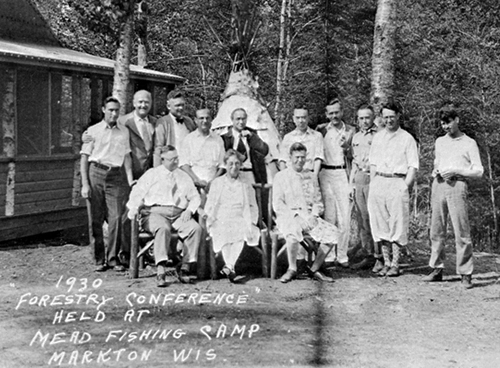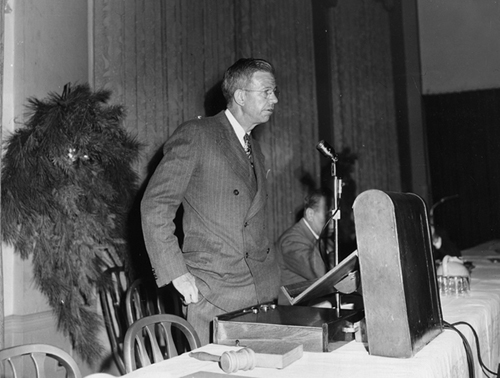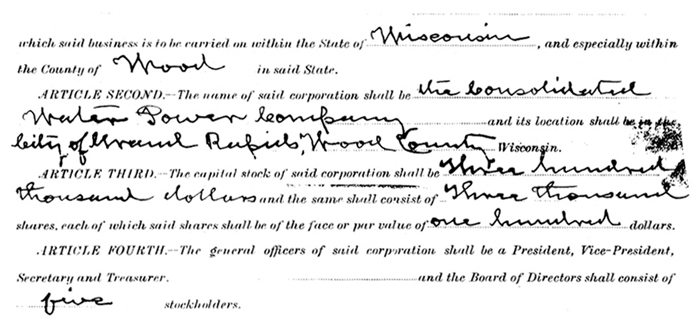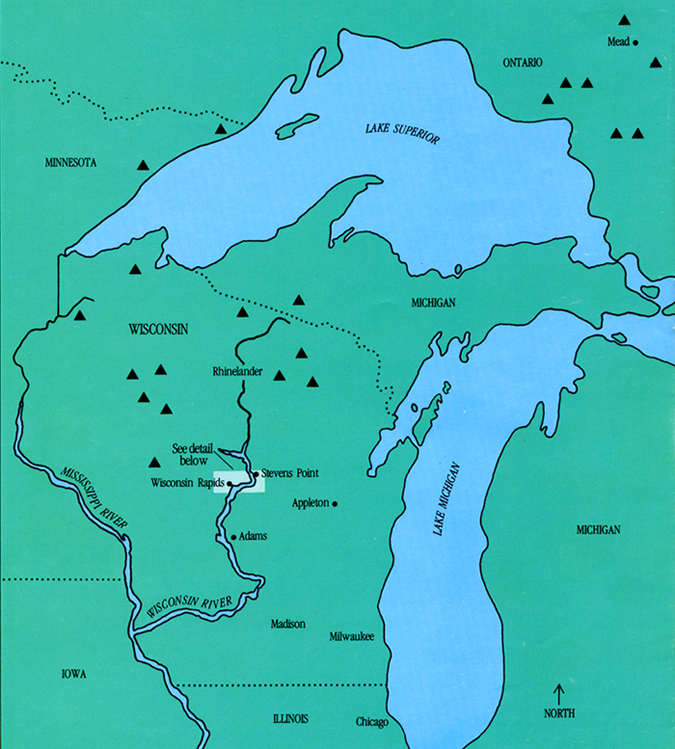July 16, 1894: Consolidated Water Power Company Formed
On this date in 1894, a group of men with water and property rights along the Wisconsin River reached a monumental agreement. The group decided to combine their holdings in order to build dams and consolidate water power in the area around Grand Rapids and Centralia (the two towns would later merge to become Wisconsin Rapids). The formal articles of organization were officially signed and dated twelve days later, and the Consolidated Water Power Company was born.
The early years of the company were wracked with disagreements over the allocation of funds, and it wouldn’t be until after the turn of the century that the ultimate direction of the company would emerge. The company’s success would eventually be found in papermaking, a shift in focus which can largely be attributed to George W. Mead.
Born in Chicago in 1871, Mead graduated from the University of Wisconsin in 1894, the same year Consolidated was formed. Mead was drawn into the company in 1902 by his ailing father-in-law, Jere Witter, a banker who owned considerable shares in Consolidated. Following Witter’s passing that year, Mead arrived in Grand Rapids to temporarily assist the company. Originally planning to stay in the area for only two weeks, Mead ended up as a resident of Grand Rapids and a permanent fixture in Consolidated’s company history.
Along with Nels Johnson, manager of the Grand Rapids Pulp and Paper Company mill in Biron (and another shareholder of Consolidated), Mead helped lead a new project: the construction of a large paper mill along with a planned dam on the Wisconsin River. The new Grand Rapids dam with attached paper and pulp mill was completed in 1904, beginning its operations with the world’s first electronically powered paper machines. By that time the company’s name had already officially changed to Consolidated Water Power & Paper Company (the name would later change again to Consolidated Papers, Inc.), Mead had taken over permanent direction, and business was on the verge of taking off.
While the company experienced major growth over the following decades, accessible pulpwood supplies in the area eventually began to dwindle. In 1930, Stanton Mead (George’s son) attended an American Forestry Association meeting in Minneapolis to learn more about the growing field of forestry. There he met a forester named Emmett Hurst and came away impressed.
A few months later, Stanton Mead hosted a private forestry conference at his family’s fishing camp in Markton. Mead invited several notable figures in the field of forestry to the August 1930 gathering, including renowned forest researcher Raphael Zon, Forest Products Laboratory head Cap Winslow, and regional forester E.W. Tinker.

Mead Forestry Conference, August 1930. You’ll find a report of the conference in the list of further readings below.
Mead used the assembled group to help determine the best direction for a potential forestry policy for his company. Zon advocated both buying second-growth forest land and adopting more sustainable partial-cutting practices (rather than the clear-cutting practices still widely used at the time). Mead took the advice to heart and decided to adopt a formal forestry program for Consolidated.
A month after the meeting, Mead offered Hurst a job leading the company’s new forestry program. Hurst jumped at the chance, arriving in Wisconsin in October and reporting for his first day of work on November 1st. One of Hurst’s first duties was to begin planning a nursery, and he quickly selected a suitable site along the Wisconsin River north of the town of Wisconsin Rapids. Development of the Biron nursery began in April 1931. By 1935, seedlings from Biron were being planted in Forest County and were also supplying the Civilian Conservation Corps for their planting operations on Wisconsin’s new national forests. In 1948, the Gagen Management Unit was established to operate as an experimental forest, dedicated to the application of research in practical forest management. The original nursery would also grow and expand, eventually moving to Monico, Wisconsin, in 1951. The company’s forestland holdings were also expanding during this time. In 1930 the company owned less than 5,000 acres of timberland, but by the 1950s, company holdings included over 200,000 acres in Wisconsin, Minnesota, and Michigan.

Stanton Mead, President of Consolidated Water Power & Paper, delivers a speech in Wisconsin Rapids, 1953.
Both Stanton Mead and Emmett Hurst would retire in 1968, but Consolidated would retain its commitment to sound forest management throughout the remainder of the century. The Consolidated Tree Farm Family Program was initiated in the 1970s to provide free forest management services to private landowners.
In February 2000, a Finnish company, Stora Enso Oyj, reached an agreement to acquire Consolidated Papers, Inc., in a transaction valued at $4.8 billion. Seven years later, Stora Enso put its North American unit up for sale and the eight factories were purchased by NewPage Holding Corporation. Today, NewPage continues to operate a large paper mill complex in Wisconsin Rapids, exactly where Consolidated began their first paper mill operations more than a century ago.
Further readings on the history of Consolidated Papers:
“Paper, Power and Pulpwood: The Story of Consolidated Paper Company,” by Larry Johns, from Forest History Today, 1997.
“Report of the Forestry Conference held at the Camp,” Markton, Wisconsin, August 15-17, 1930.
Remarks delivered by Emmett B. Hurst at the Silver Anniversary of Industrial Forestry Operations at Consolidated, October 30, 1967, in Rhinelander, Wisconsin.
An excerpt from “Consolidated’s Concern for Our Forests,” a promotional publication produced to commemorate 50 years of company forestry.



